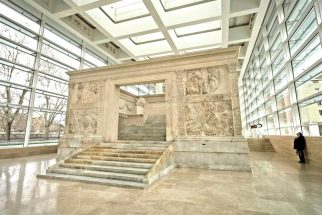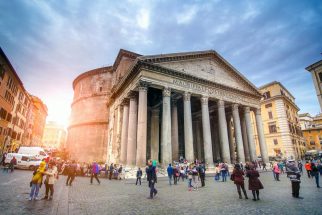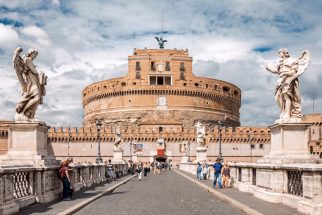The Ara Pacis, the Augustean Altar of Peace, is a commemorative monument that was erected in Rome between the years 13 and 9 B.C. to celebrate peace in the Mediterranean after the victorious battles of Emperor Augustus in Hispania and Gaul. The marble structure is a masterpiece of Roman sculpture. In the Greco-Roman era, most of the architectures and basreliefs were finely pigmented in polychromy. It is therefore assumed that the panels of the Ara Pacis Augustae were also painted. This monument represents one of the most significant surviving testimonies of Augustan art and it intended to symbolize the peace and the prosperity achieved as a result of the Pax Romana. Originally established on the northern outskirts of Rome, the Ara Pacis stood in the northeastern corner of the Campus Martius, the former flood plain of the Tiber River and gradually became buried under 4 metres (13 ft) of silt deposits. It was reassembled in its current location, now the Museum of the Ara Pacis, in 1938, turned 90° counterclockwise from its original position so that the original western side now faces south.
Although the Ara Pacis is one of the most significant monuments of Ancient Rome, it is the only thing that is exhibited in the interior of the museum, the Museum of the Ara Pacis. The Ara Pacis is an altar located in the interior of a closed structure carved in Carrara marble. It stands out because of its impressive decoration made up of various reliefs showing the family of Augustus in procession, in addition to different allegories related to the mythical foundation of Rome.
The Museum of the Ara Pacis belongs to the Sistema dei Musei in Comune of Rome. Designed by the American architect Richard Meier and built in steel, travertine, glass and plaster, the museum is the first great architectural and urban intervention in the historic centre of Rome since the Fascist era. It is a structure with a triumphal nature, clearly alluding to the style of imperial Rome. Wide glazed surfaces allow the observer to appreciate the Ara Pacis with uniform lighting conditions.
How to best experience Ara Pacis?
Tickets, tours, and activities for Ara Pacis are available at these providers:
Click on the logos below to easily compare prices.



Feeling lucky? Try the direct search:
GetYourGuide.com Viator.com Trip.com Expedia.com Tiqets.com Ctrip.com (中文)Location data not available.
Best Ara Pacis Tickets
Roma Pass: 48 or 72-Hour City Card
/5See more of the Eternal City and save money with a Roma Pass for 48 or 72 hours. This city card offers free skip-the-line admission to 1 or 2 attractions, free use of the city’s public transport system, and discounts on services and activities.
As low as
€33
on GetYourGuide.com
What is the Ara Pacis?
The Ara Pacis is a commerative altar built between the years 13 and 9 B.C. to celebrate Emperor Augustus’ victories in Hispania and Gaul.
What does “Pax Romana” mean?
The expression “Pax Romana” refers to the time period from 27 B.C.E. to 180 C.E. in the Roman Empire. This 200-year period saw unprecedented peace and economic prosperity throughout
the Empire, which spanned from England in the north to Marocco in the south and Iraq in the east.
What is the size of the Ara Pacis?
The altar consists of a rectangular, not covered,with dimension of 11.65×10.62×4.60 metres, made of Carrara marble.
General information
Useful information for your visit to the Museum of the Ara Pacis.
Location
The Museum of the Ara Pacis is in Lungotevere in Augusta (corner via Tomacelli)
Opening hours
To visit the Ara Pacis the times are as follows:
- Tuesday – Sunday: 9 am – 7 pm
- The Museum of the Ara Pacis is closed on January 1st, May 1st and December 25th
How to get to the Museum of the Ara Pacis
To reach the Museum of the Ara Pacis:
Buses: 70, 81, 117, 119, 186 and 628.
Taxi: an effective way to get around Rome (click to see the guide to taxis in Rome)
Limo service (NCC): (click to see the guide to limo services in Rome)
Attractions nearby
- Piazza del Popolo (499 m)
- Piazza di Spagna & the Spanish Steps (563 m)
- Keats-Shelley House (583 m)
- Santa Maria del Popolo (590 m)
- National Roman Museum (599 m)










